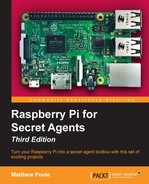In this chapter, we got acquainted with the two components involved in camera handling under Linux: the USB Video Class drivers and the Video4Linux framework. You learned how to obtain important information about your camera's capabilities; you also learned a bit about pixel formats, image resolution, and frame rates.
We proceeded to set up a video feed, accessible directly via a web browser or through VLC media player, which we could also use to record the stream for permanent storage.
Then we jumped head first into surveillance and motion detection systems with the help of the Motion and MotionEye applications. You learned how to create an initial configuration suitable to verify and tweak the motion detection mechanism, and how to set off alarms upon detection. We also explored how to view that evidence and have it delivered to our smartphone by e-mail.
Not content with letting any unused webcams in the home go to waste, we explored how to hook up additional camera streams to the MotionEye system to take advantage of its security monitoring wall.
We then made our camera feed easily viewable over the Internet, with the help of a broadcasting service that picked up our camera feed through an RTMP stream.
We also looked at how to make use of CEC technology to remotely control the TV connected to the Pi, a neat trick that came in handy for our last and boldest prank: the creepy playback scare.
In the upcoming chapter, we'll dive deep into the world of computer networks and you'll learn how to be in complete control over your Wi-Fi access point.
